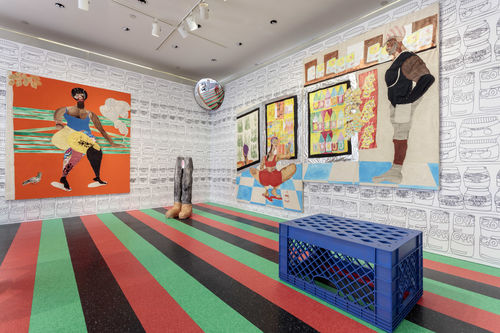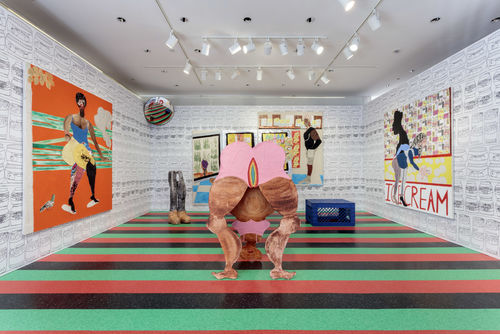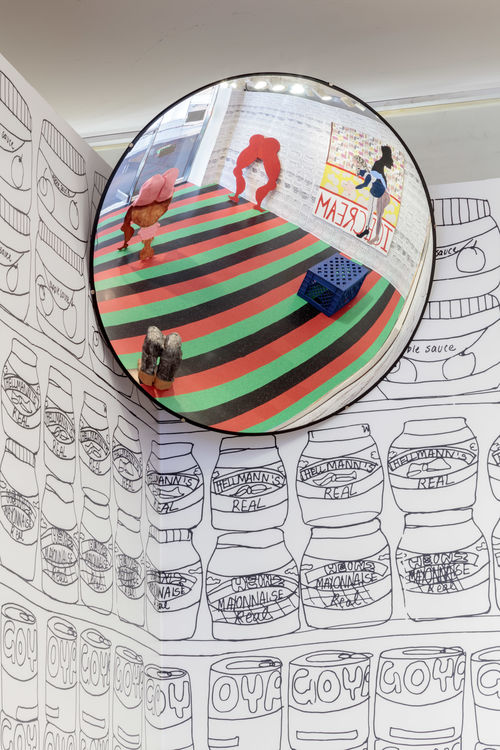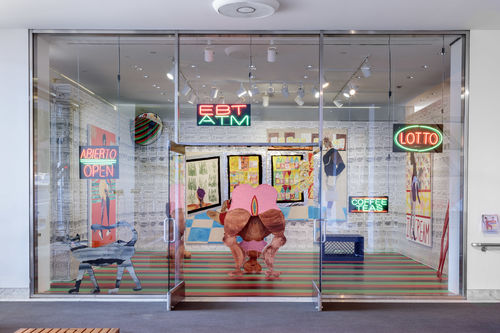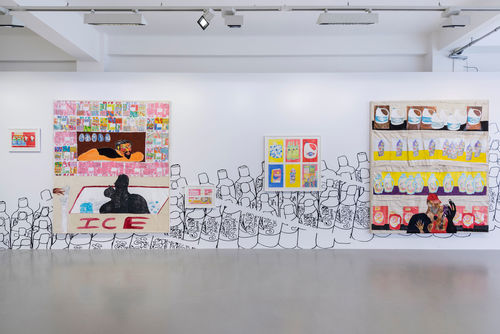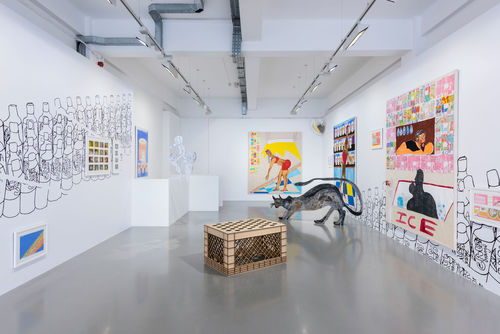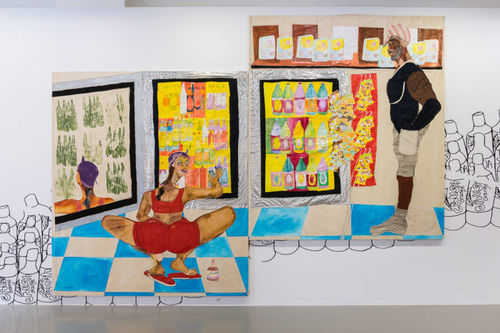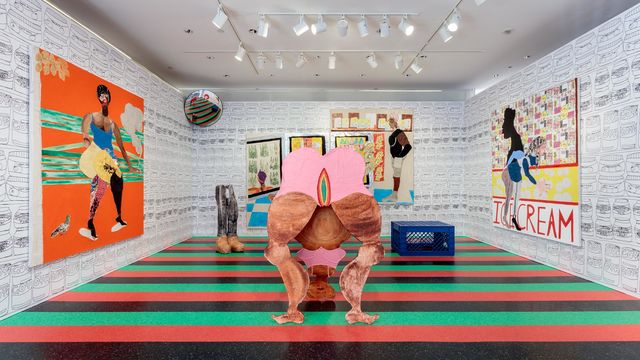
Hammer Projects: Tschabalala Self
- – This is a past exhibition
Self's project Bodega Run examines the neighborhood convenience store as both a gathering place for community and a microcosm of how current economic and political issues are impacting people’s lives.
Working across a range of mediums, including painting, print-making, sculpture, collage, sewing, and installation, Tschabalala Self often depicts ample, powerful, and self-contained figures to explore cultural attitudes toward race and gender. Simultaneously embracing and rejecting stereotypes and fantasies that revolve around black women’s bodies in particular, her lively and spirited portrayals propose new forms of representation that are empowered and celebratory.
For her Hammer Project, Self presents the fifth, and final, iteration of her project Bodega Run, which examines the neighborhood convenience store as both a gathering place for community and a microcosm of how current economic and political issues are impacting people’s lives. Presented in the Hammer’s lobby gallery as a vibrant corner store, the installation includes wallpaper made from Self’s simple line drawings of foods commonly available on market shelves, a tiled linoleum floor, paintings of customers shopping amongst colorful patterns of products, and freestanding sculptures portraying silhouetted animals and a shopkeeper, as well as electronic LED signs in the window emblematic of the various economies that operate in these settings. Bodegas are commonplace in Harlem, where Self was born and continues to reside, and the Bodega Run series traces some of the changes of ownership and demographics associated with these small stores and how they reflect the shifting identities of urban neighborhoods.
Hammer Projects: Tschabalala Self is organized by Anne Ellegood, senior curator.
Biography
Tschabalala Self (b. 1990, New York City) lives and works in Harlem and New Haven, CT. She received her BA from Bard College in 2012 and her MFA from the Yale School of Art in 2015. Selected recent solo exhibitions include Bodega Run, Yuz Museum, West Bund Shanghai (2018); Bodega Run, Pilar Corrias Gallery, London (2017); Sour Patch, Thierry Goldberg, Miami (2017); Tschabalala Self, Tramway, Glasgow (2017); Tschabalala Self, Parasol Unit Foundation for Contemporary Art, London (2017); Gut Feelings, Thierry Goldberg, New York (2016); Desire, Moore Building, Miami (2016); The Function, T293, Naples (2016); Out of Body, Thierry Goldberg, New York (2015); and Tropicana, The Cabin, Los Angeles (2015). Recent group exhibitions include The Beyond: Georgia O’Keeffe and Contemporary Art, Crystal Bridges Museum of American Art, Bentonville, AR (2018); Trigger: Gender as a Tool and a Weapon, New Museum of Contemporary Art, New York (2017); A Shape That Stands Up, Art + Practice, Los Angeles (2016); and A Constellation, Studio Museum in Harlem, New York (2015). Self is currently an artist-in-residence at the Studio Museum in Harlem (2018–19).
Essay
It is a peculiar sensation, this double-consciousness, this sense of always looking at one’s self through the eyes of others.
—W. E. B. Du Bois
New York City is a patchwork quilt of distinct neighborhoods spread across all five boroughs and punctuated by renowned cultural and historic landmarks—the Empire State Building, the Statue of Liberty, the Brooklyn Museum, the Bronx Zoo, Rockefeller Center, and Central Park, among so many others. But one of the city’s defining features, albeit less iconic than those noted above, found in all its far-flung parts, is the bodega. The history of these now ubiquitous small neighborhood markets tells the story of immigration and urban development in New York in the latter half of the twentieth century. Tracing how the bodega has changed in recent decades and its role in contemporary urban life sheds light on the impacts of gentrification in the city and on broader cultural and economic trends taking place around the country. The first bodegas were opened primarily by Puerto Ricans—thus the use of the Spanish word for “wine cellar,” “storeroom,” or “grocery store”—as early as the 1940s, and they multiplied in the 1960s and 1970s with the influx of immigrants from the Dominican Republic and other countries in the Caribbean and Latin America. Originally most were opened in low-income and middle-class neighborhoods, catering to Spanish-speaking residents by offering staples not readily available in mainstream grocery stores at the time, such as tortillas and plantains. Today there are more than twelve thousand bodegas in New York City, and for locals and tourists alike, they are the go-to spots to pick up a pack of gum, a bottle of water, a lottery ticket, or some cat food. Most New Yorkers cannot imagine life without the local bodega.
Despite their prevalence and relatively homogeneous appearance, most bodegas today maintain a distinctly local flavor and exist largely to serve neighborhood residents. They are still owned predominantly by people of color—with Middle Eastern, primarily Yemeni, and Asian owners joining the ranks of Latin Americans—and tend to be family owned and run. In addition to offering wide-ranging fare, bodegas are often social spaces where people from diverse backgrounds know one another by name and gather to gossip, debate the news, and talk about their problems. Bodega owners frequently describe feeling close to their customers and say that their role includes giving sound advice.1
Tschabalala Self grew up in Harlem and still calls it home, and her familiarity with the bodega inspired her series of installations titled Bodega Run. These immersive installations, which emulate the experience of walking into one of these densely stocked and surprisingly vibrant corner stores, pay homage to the bodega as an important factor in the financial independence of many immigrant families and as an integral component of any given neighborhood while also critiquing some of its operations. The Bodega Run project might also be understood as a plea to stand by these beloved neighborhood institutions at a time when gentrification and rising rents are causing them to be displaced by chain stores. Self recognizes the bodega as a microcosm of larger changes within urban development and the financial systems that support it, which are making it more and more difficult for independent business owners to compete. This pressure has led to the diversification of what is on offer, sometimes in positive ways, with owners providing fresh foods prepared in-house or adding conveniences like ATM machines in areas where banks are scarce. But in general the bodega has survived by exploiting vulnerabilities, selling common indulgences like lottery tickets, tobacco products, and highly processed junk foods that contribute directly to poor health and obesity.
Self’s depictions of seemingly never-ending rows of two-liter bottles of soda, a woman leaning over a freezer filled with ice cream, and pockets lined with candies are clearly commentaries on the allure of these sugar-filled foods and their plentiful availability in the bodega. Her hand-drawn animation Wild Blue Cherry (2017) shows a young woman drinking a bottle of soda manufactured by Tropical Fantasy, a Brooklyn-based company known for marketing its products in low-income, largely black and Latinx neighborhoods. Some of the goods Self pictures in her drawings and paintings signal the ethnicities of the store owners and the communities they serve. Her painting Bayo (2017), for example, features a woman wearing an inexpensive spandex two-piece walking past shelves of canned pickled jalapenos produced by the Mexican brand La Morena and holding a bottle of Presidente, a beer produced in the Dominican Republic. Works such as Koco at the Bodega (2017), in which a woman hands a cashier a dollar to pay for a single cigarette against a backdrop of temptingly colorful lottery tickets, shine a spotlight on the types of transactions that are encouraged within the bodega. Loosie in the Park (2019)—created for Self’s Hammer Project—portrays a woman smoking a cigarette on a park bench, thus tracing the life cycle of products purchased in the bodega into the outdoor environment and, indeed, into her subject’s body.
Despite Self’s concerns about the role of the bodega in perpetuating habits that are ultimately harmful, her Bodega Run series also celebrates these sites as family-owned businesses that are important alternatives to monolithic and impersonal chain stores, offering much more to communities than the selling of merchandise. The artist has described the bodega as “a lighthouse in an ocean of gentrification, a relic from times past. The bodega is and was a space created for people of color by people of color, to serve the needs of communities of color. A hood menagerie, the bodega is emblematic of black metropolitan life.”2
Like the ample and resplendent black women who were the subjects of the lively paintings that first garnered Self recognition, the figures inhabiting her bodegas are lovingly conceived and depicted, each a unique character in a familiar yet abstract narrative. Quotidian activities like picking up a bottle of laundry detergent are punctuated by moments of connection—as with the couple kissing in Fresh (2017)—and of relaxation, embodied by the man having a smoke on the stoop of an apartment building in Blunt (2018). While Self’s characters are undeniably visually alluring and charismatic, what sets them apart is in fact their ordinariness. They are not heroes or celebrities. They are not the subjects of headline news or the winners of awards. They are simply people whose everyday lives, Self argues, are worthy of representation and contemplation. Like the painters Kerry James Marshall and Noah Davis, Self takes as her subjects average people but presents them as richly rendered black and brown bodies. She is committed to representing black figures as poised, confident, and self-possessed, an ideological position shared by other artists of her generation, such as Toyin Ojih Odutola and Deana Lawson, who are similarly dedicated to portraying people of color in ways that acknowledge their multitudinous potential manifestations within what the theorist Jared Sexton would describe as “an unlimited field.”3
Self’s work adds complexity and depth to the politics of representation that have historically informed the relationship between the artist and the subject. Forms of representation in which a person is reduced to a fetishized object by someone typically outside their social group or community are still quite common. Yet in our technologically networked and always connected new reality, the one-way street of the voyeuristic gaze has become more like an endless loop or a web of avenues going in too many directions to adequately map. Voyeurism as a phenomenon has far exceeded what even the most astute prognosticators among us might have imagined. We are all being watched—in a variety of ways—more than ever before and participating in self-perpetuating systems of observation and scrutiny that rely on superficial notions of connectivity and reciprocity. There remains ample room for conventional voyeuristic observation, yet today such acts might be met with immediate responses—either judgments (of the thumbs-up, “like,” or angry emoji kind) or, more importantly, alternatives in which the roles of typical onlooker and likely subject are reversed or the gaze is deflected amid numerous opportunities for self-representation across social media platforms. But as the artist and writer Aria Dean so astutely pointed out in her discussion of blackness and the digital realm, “Closing the Loop,” the very fact of visibility and the actions put into place to enhance, limit, or even erase it are quite distinct for different groups of people, for “to be Black in particular is to be at once surveilled and in the shadows, hypervisible and invisible.”4
Artists like Self are complicating the dynamics of observer and observed. Dean’s updated thinking on the type of double consciousness articulated by W. E. B. Du Bois more than a century ago has also been articulated by Self in her discussions of the figures she renders: “You have an image of yourself that you imagine other people perceive you as. I think that something people that are marginalized have [is] that sense of double consciousness. You have to [have] it because otherwise if you didn’t, you’d be putting yourself in precarious situations.”5 Her statement acknowledges the types of anxiety and risk that Dean also points to: the constant double bind of the urgent need for forms of representation that are celebratory and nuanced (at times even in their banality) and the ways in which visibility can attract egregious forms of stereotyping and provide opportunities for bullying (remember the reprehensible trolling of Leslie Jones?). More alarmingly, it can in fact lead to violence. Within this context Self’s figures—who are shamelessly and unabashedly present—fill a void produced by the perils of invisibility, but the artist also creates an entirely alternative system for the construction and consumption of images of bodies of color. Her choice of materials and processes mirrors the complexity of her characters. The layers of their lives and experiences are manifest in the cut and sometimes folded fabrics that she collages together and the variety of materials—including velvet, denim, sequins, and mirrors—deployed. The visible stitching on her canvases and the simple structural compositions of her sculptures foreground the process of making in order to elucidate the notion that we are all always in the act of becoming, and it is in our states of imperfection, incompletion, and striving that we find our humanity. Self’s characters are sensual and animated, calling to mind James Baldwin’s words: “To be sensual . . . is to respect and rejoice in the force of life, of life itself, and to be present in all that one does, from the effort of loving to the breaking of bread.”6 As the artist herself has put it, “my work is celebratory because one must thrive despite destructive rhetoric.”7
Notes
Epigraph: W. E. B Du Bois, “Strivings of the Negro People,” Atlantic Monthly, August 1897, 195.
1. “Bodegas: Living the American Dream,” CBS News, April 9, 2017, https://www.cbsnews.com/video/bodegas-living-the-american-dream/.
2. Tschabalala Self, “A Hood Menagerie,” in Bodega Run, exh. brochure (Shanghai: Yuz Project Space for Art, 2018), unpaged.
3. See “On Black Negativity, or the Affirmation of Nothing: Jared Sexton Interviewed by Daniel Colucciello Barber,” Society + Space, September 18, 2017, http://societyandspace.org/2017/09/18/on-black-negativity-or-the-affirmation-of-nothing/.
4. Aria Dean, “Closing the Loop,” New Inquiry, March 1, 2016, https://thenewinquiry.com/closing-the-loop/.
5. Self, quoted in Jason Parham, “The Hypervisible Black Women of Tschabalala Self’s World,” Fader, April 20, 2017, https://www.thefader.com/2017/04/20/tschabalala-self-interview.
6. James Baldwin, The Fire Next Time (1963; New York: Vintage, 1993), 43.
7. Self, quoted in Emily Steer, “5 Questions with Tschabalala Self,” Elephant, January 16, 2017, https://elephant.art/5-questions-tschabalala-self/.
Hammer Projects is presented in memory of Tom Slaughter and with support from the Horace W. Goldsmith Foundation.
Lead funding is provided by Hope Warschaw and John Law and by the Hammer Collective. Generous support is also provided by Susan Bay Nimoy and Leonard Nimoy, with additional support from Good Works Foundation and Laura Donnelley, and the Los Angeles Board of Supervisors through the Los Angeles County Arts Commission.



